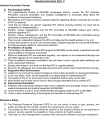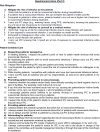Link of Infection Prevention Climate to Patient-Centered Care: Role of Workplace Safety and Risk Mitigation
- PMID: 38352960
- PMCID: PMC10863469
- DOI: 10.2147/RMHP.S439907
Link of Infection Prevention Climate to Patient-Centered Care: Role of Workplace Safety and Risk Mitigation
Abstract
Background: Healthcare-associated infections pose a substantial threat to the quality of healthcare services. Consequently, it is imperative for hospital organizations to actively support an infection prevention climate, fostering workplace safety and risk mitigation, thereby promoting patient-centered care.
Purpose: This study aims to explore the interconnectedness between the infection prevention climate, workplace safety, risk mitigation, and patient-centered care.
Methods: A cross-sectional study design was employed, utilizing a questionnaire administered to 235 healthcare professionals in intensive care and inpatient units at Bandung Kiwari Regional General Hospital. Data analysis was conducted using partial least squares structural equation modeling (PLS-SEM) with SmartPLS 4 and SPSS 25.
Results: The study revealed several significant relationships, including (1) between infection prevention climate and patient-centered care; (2) infection prevention climate and workplace safety; (3) workplace safety and patient-centered care; (4) infection prevention climate and patient-centered care mediated by workplace safety; (5) infection prevention climate and risk mitigation; (6) risk mitigation and patient-centered care; (7) and the relationship between infection prevention climate and patient-centered care mediated by risk mitigation.
Conclusion: Infection prevention climate emerges as a crucial intangible value that hospital organizations can cultivate to shape workplace safety. This, in turn, encourages healthcare workers' compliance in implementing infection prevention controls as a form of risk mitigation, ultimately contributing to the provision of patient-centered care.
Keywords: healthcare-associated infections; infection prevention climate; patient-centered care; risk mitigation; workplace safety.
© 2024 Rumintang Marito and Widianto.
Conflict of interest statement
The authors report no conflicts of interest, ensuring the transparency and integrity of the research process. Overall, this study contributes valuable knowledge to the ongoing efforts to enhance infection prevention, workplace safety, and patient-centered care in healthcare settings.
Figures




Similar articles
-
Exploration of COVID-19 Pandemic Prevention Behaviors among Healthcare Workers.Healthcare (Basel). 2023 Jan 4;11(2):153. doi: 10.3390/healthcare11020153. Healthcare (Basel). 2023. PMID: 36673522 Free PMC article.
-
Variations in Workplace Safety Climate Perceptions and Outcomes Across Healthcare Provider Positions.J Healthc Manag. 2020 May-Jun;65(3):202-215. doi: 10.1097/JHM-D-19-00112. J Healthc Manag. 2020. PMID: 32398531
-
The mediating role of safety compliance and participation in the relationship between safety climate and nurses' sustainable work outcomes.Work. 2025 May 29:10519815251346474. doi: 10.1177/10519815251346474. Online ahead of print. Work. 2025. PMID: 40443164
-
Workplace Ethical Climate and Workers' Burnout: A Systematic Review.Clin Neuropsychiatry. 2023 Oct;20(5):405-414. doi: 10.36131/cnfioritieditore20230502. Clin Neuropsychiatry. 2023. PMID: 38089739 Free PMC article. Review.
-
Hospital safety climate surveys: measurement issues.Curr Opin Crit Care. 2010 Dec;16(6):632-8. doi: 10.1097/MCC.0b013e32833f0ee6. Curr Opin Crit Care. 2010. PMID: 20827181 Review.
References
-
- Tardivo S, Moretti F, Nobile M, et al. Definition of criteria and indicators for the prevention of Healthcare-Associated Infections (HAIs) in hospitals for the purposes of Italian institutional accreditation and performance monitoring. Ann Ig. 2017;29:529–547. - PubMed
LinkOut - more resources
Full Text Sources

